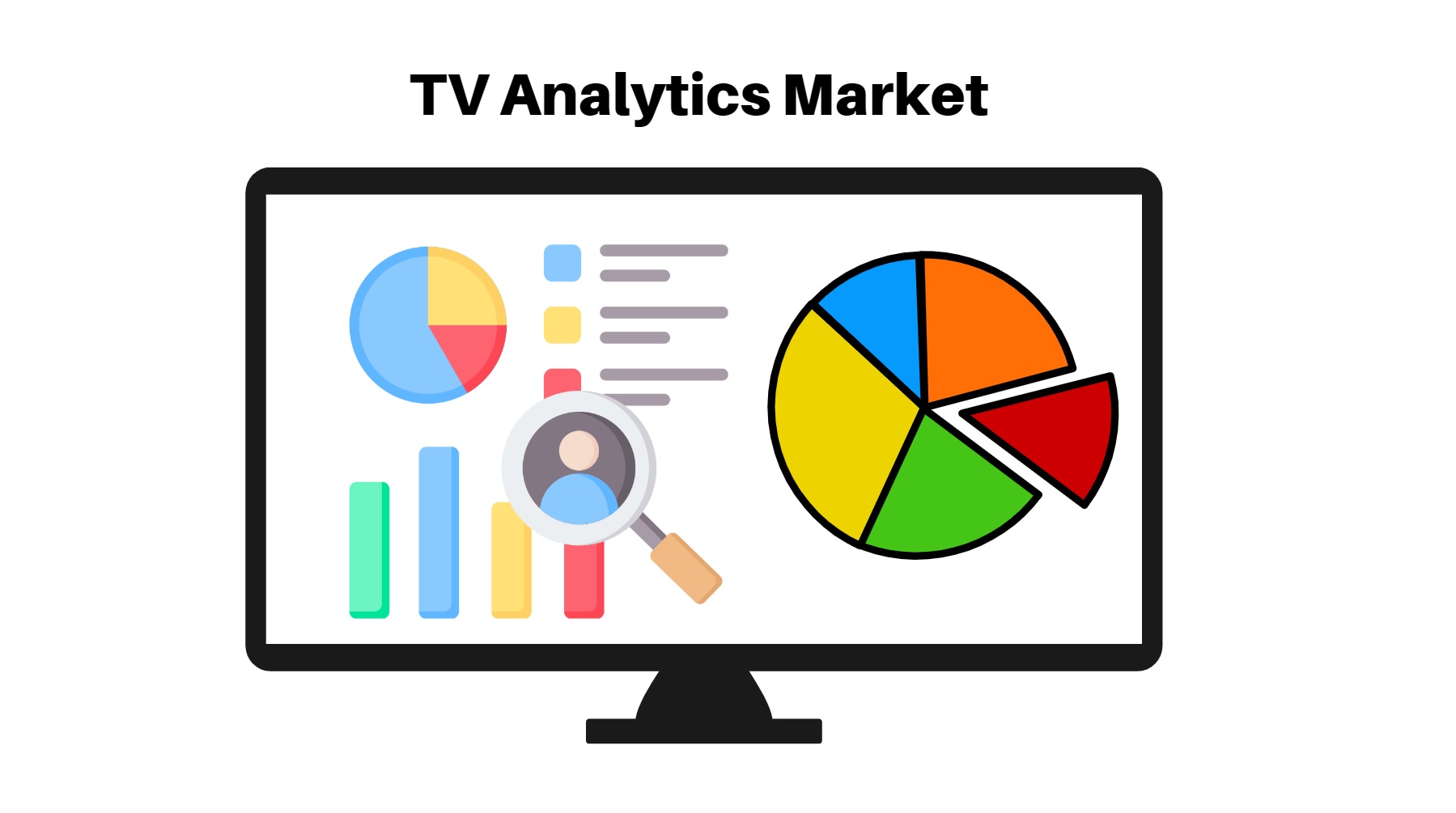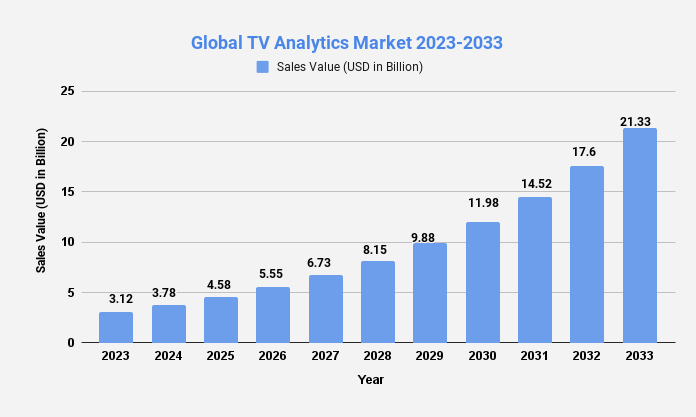TV Analytics Market Size is valued at USD 3.12 billion in 2023, growing at a CAGR of 21.2%

Page Contents
The global TV Analytics market is valued at USD 3.12 billion in 2023 and is projected to reach USD 21.33 billion by 2033, growing at a CAGR of 21.2% from 2023 to 2033.
There are different types of TV analytics, including audience measurement, content analysis, and advertising effectiveness. Audience measurement involves tracking and analyzing viewer data, such as ratings, demographics and viewing habits. Content analytics focuses on analyzing the quality and performance of television content, including programming, genre and engagement metrics. Advertising effectiveness analytics measure the effectiveness of TV ads in reaching and engaging target audiences.
TV analytics can be used by media companies to make decisions on programming, scheduling and content creation. Advertisers can use TV analytics to determine the reach and effectiveness of their ads, target specific audiences, and optimize their ad campaigns.

Key Takeaways
- Audience measurement-TV analytics can measure target audience measurement and demographics for a specific program, channel or time slot. These statistics can be used to inform programming selections and help advertisers goal-specific audience segments.
- Content Analysis-TV analytics can analyze the content material of TV packages to identify themes, topics, and emotions. These statistics can be used to recognize audience preferences and become aware of opportunities for new programming.
- Ad Effectiveness-TV analytics can measure advert effectiveness via tracking viewer engagement, which includes advert recall, engagement, and purchase behavior. Advertisers can use these records to optimize their campaigns and goal the right audience.
- Social media integration-TV analytics can integrate with social media structures to measure target market engagement with TV shows and advertisements on social media. This data can help networks and advertisers recognize the impact of social media on TV viewing behavior.
- Cross-device measurement– TV analytics can measure TV viewing throughout multiple devices, consisting of cellular phones, tablets, and streaming devices. This information can help networks and advertisers understand how viewers are ingesting TV content material and goal audiences across one-of-a-kind platforms.
Request For Sample Report Before Purchasing: https://marketresearch.biz/report/tv-analytics-market/request-sample/
Regional Snapshot-
- North America– The United States and Canada are the main markets for TV analytics, with many groups supplying statistics and analytics services to broadcasters, advertisers and other stakeholders.
- Europe– Many international locations in Europe have well-established TV industries and a robust way of life of target market measurement. Companies such as Kantar Media, Ipsos and GfK are important players in the European TV analytics market.
- Asia-Pacific– The Asia-Pacific place is home to some of the largest TV markets in the world, together with China, Japan and South Korea. TV analytics is becoming increasingly vital in these markets as broadcasters and advertisers are searching for to apprehend and attain their audiences greater effectively.
- Latin America– Countries in Latin America have a fast-growing TV industry, with a particular center of attention on telenovelas and other types of Spanish-language programming. TV analytics are an increasingly being used in the area to understand viewer conduct and preferences.
- Middle East and Africa– The Middle East and Africa have a numerous range of TV markets with various levels of technological sophistication and viewer behavior. TV analytics are used in these regions to recognize target market demographics, viewing habits and marketing effectiveness.
Drivers
- With the rise of streaming offerings and on-demand programming, viewers have more preferences than ever earlier than when it comes to what they watch on TV. This has created a need for TV analytics to assist content material carriers and advertisers understand how viewers are ingesting content material across different platforms.
- Advertisers desire to reach their target audience as successfully as possible, and TV analytics can assist them do this by using offering statistics on viewer habits and demographics. This approves advertisers to tailor their ad campaigns to precise audiences, leading to better ROI and greater conversion rates.
- Programmatic marketing is the computerized shopping for and promoting of digital marketing area and is turning into extra frequent in the TV industry. With the rise of digital TV and streaming services, more facts is on hand on TV viewership and engagement than ever before. TV analytics can help groups make feel of these records and use it to make more informed choices about programming, advertising, and different components of their business.
Restraints
- Accessing comprehensive and accurate data on TV viewership can be a challenge, particularly when it comes to measuring audience engagement and sentiment. Many television networks and service providers restrict viewership data due to privacy concerns. TV analysis often relies on a sample of viewers that may not accurately reflect the wider population, leading to biased results and misinterpreted insights.
- Furthermore, because television programming can be intricate and nuanced, the effective analysis may prove difficult due to this factor alone. Understanding the context, subtext, and significance behind TV shows and their effect on viewers necessitates an in-depth knowledge of the cultural, social, and historical milieus in which they are created and consumed.
- No standard method exists for conducting TV analysis, making it difficult to compare results across different studies or regions. Furthermore, the industry is rapidly evolving with new technologies and platforms appearing daily – keeping up with these modifications and adapting analytics methods accordingly can prove a daunting challenge.
Opportunities
- TV analytics is the collection, measurement, analysis and interpretation of data related to television content and viewership. TV analytics helps media companies, advertisers and producers better understand what resonates with viewers so they can create targeted content tailored specifically for specific audiences.
- TV analytics also aids producers and broadcasters make informed decisions about programming; by analyzing viewership data they can determine which shows perform well and which do not. With this insight they can decide which shows to renew, cancel or make changes accordingly; TV analytics even assists advertisers in reaching their intended audience more efficiently.
Place An Inquiry Before Purchase- https://marketresearch.biz/report/tv-analytics-market/#inquiry
Challenges
- TV data is collected from various sources such as set-top boxes, smart TVs, and streaming devices, making it difficult to collect and analyze the information. Furthermore, there is no standardization in place for TV metrics which makes comparing data across platforms and networks challenging.
- Traditional audience measurement methods, such as Nielsen ratings, have become less accurate and relevant in the digital media age.
- Collecting and analyzing TV data raises privacy issues among viewers who do not want their viewing habits tracked. TV generates vast amounts of data which can be difficult to process quickly or cost-effectively; furthermore, the accuracy and completeness of TV data depend on its source and collection method.
Recent-Development
- Advanced Audience Measurement– TV Analytics now makes use of advanced target market measurement methods to tune the viewing behavior of individual viewers throughout multiple devices.
- Real-time facts collection- With the upward jostle of real-time facts collection and processing, TV analytics can now supply broadcasters with real-time insights into how their audience is engaging with their content.
- AI-powered analytics- AI-powered TV analytics are now succesful of rapidly and accurately inspecting giant amounts of data, enabling broadcasters to make knowledgeable decisions about their programming and advertising strategies.
- Cross-platform measurement– TV Analytics is now capable to tune viewership throughout multiple gadgets and platforms, inclusive of linear TV, OTT and cell devices. It presents broadcasters with a greater comprehensive view of their target audience and helps them optimize their programming and marketing techniques for most attain and engagement.
- Enhanced Ad Measurement– TV Analytics is now capable to grant more designated records on how viewers are enticing with ads, which includes metrics such as advert viewability, completion prices and engagement rates.
Market Segmentation
Segmentation by TV Transmission types:
- Cable TV
- Satellite TV/DTH
- Over-The-Top (OTT)
- Internet Protocol television (IPTV)
Segmentation by Deployment Mode:
- Cloud
- On-Premises
Key Players
- Amazon Web Services, Inc.
- Avaya Inc.
- Capgemini SE
- Entrust Datacard Corporation
- Huawei Technologies Co., Ltd.
- International Business Machines Corporation
- Imex Systems Inc.
- OpenGov, Inc.
- Oracle Corporation
Socrata, Inc.
Report Scope
| Report Attribute | Details |
| The market size value in 2023 | USD 3.12 billion |
| Revenue forecast by 2033 | USD 21.33 billion |
| Growth Rate | CAGR Of 21.2% |
| Regions Covered | North America, Europe, Asia Pacific, Latin America, and Middle East & Africa, and Rest of the World |
| Historical Years | 2017-2022 |
| Base Year | 2022 |
| Estimated Year | 2023 |
| Short-Term Projection Year | 2028 |
| Long-Term Projected Year | 2033 |
Key Questions
Who is watching my content?
TV analytics can help discover demographic characteristics of your audience, such as age, gender, place and interests.
What content is performing well?
By analyzing target audience engagement metrics such as viewership, scores and social media activity, TV analytics can assist discover what content material is resonating with viewers.
What advertising is effective?
TV analytics can tune the overall performance of advert campaigns, which include advert impressions, reach, engagement and conversion rates.
How are viewers attracted to my content?
TV analytics can provide insights into viewer engagement, consisting of which episodes of a program are most attractive and how viewers are interacting on social media and other systems while watching.
How can I enhance my content and marketing strategy?
By inspecting target audience behavior and content material performance, TV analytics can assist pick out opportunities for enchancment and optimization.
The team behind market.us, marketresearch.biz, market.biz and more. Our purpose is to keep our customers ahead of the game with regard to the markets. They may fluctuate up or down, but we will help you to stay ahead of the curve in these market fluctuations. Our consistent growth and ability to deliver in-depth analyses and market insight has engaged genuine market players. They have faith in us to offer the data and information they require to make balanced and decisive marketing decisions.